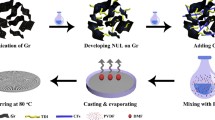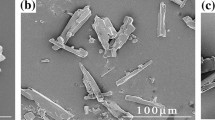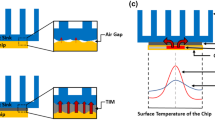Abstract
In this work, a facial approach was proposed to improve the thermal and electrical conductivity of poly(vinylidene fluoride) (PVDF) by constructing a segregated graphene nanoplatelets (GNP) network structure. PVDF/GNP composites with segregated filler network were fabricated by coating GNP on the surface of PVDF powders using ball milling treatment, followed by compression molding technique. PVDF powders of different particle size (e.g., 100 and 400 μm) were employed to elucidate the influence of matrix particle size on the properties of PVDF/GNP composites. Results showed that the formation of segregated GNP network contributed to a concurrent enhancement of both thermal and electrical conductivity of corresponding composites. A thermal conductivity as high as 2.23 W/mK coupling with an electrical conductivity of about 0.2 S/m was achieved for segregated PVDF100/GNP 6 wt% composite, which demonstrates potential applications in the areas that require both high electric and heat dissipations.






Similar content being viewed by others
References
He S, Zhang J, Xiao X, Hong X (2018) Effects of ultrasound vibration on the structure and properties of polypropylene/graphene nanoplatelets composites. Polym Eng Sci 58(3):377–386
Zhou S, Chen Y, Zou H, Liang M (2013) Thermally conductive composites obtained by flake graphite filling immiscible Polyamide 6/Polycarbonate blends. Thermochim Acta 566:84–91
Bai Y, Shi Y, Zhou S, Zou H, Liang M (2021) A Concurrent Enhancement of Both In-Plane and Through-Plane Thermal Conductivity of Injection Molded Polycarbonate/Boron Nitride/Alumina Composites by Constructing a Dense Filler Packing Structure. Macromol Mater Eng 306(9):2100267
Thomas S, George SC, Thomas S (2018) Evaluation of mechanical, thermal, electrical, and transport properties of MWCNT-filled NR/NBR blend composites. Polym Eng Sci 58(6):961–972
Lyu M, Choi T (2015) Research trends in polymer materials for use in lightweight vehicles. Int J Precis Eng Man 16(1):213–220
Guo Y, Ruan K, Shi X, Yang X, Gu J (2020) Factors affecting thermal conductivities of the polymers and polymer composites: A review. Compos Sci Technol 193(6402):108134
Han Z, Fina A (2011) Thermal conductivity of carbon nanotubes and their polymer nanocomposites: A review. Prog Polym Sci 36(7):914–944
Yan H, Mahanta NK, Majerus LJ, Abramson AR, Cakmak M (2014) Thermal conductivities of electrospun polyimide-mesophase pitch nanofibers and mats. Polym Eng Sci 54(4):977–983
Yang Y, Gao J, Lei T, Yang J, Wang J, Liu J (2020) Thermal conductivity and mechanical properties of polyimide composites with mixed fillers of BN flakes and SiC@SiO2 whiskers. Polym Eng Sci 60(5):1044–1053
Zhou S, Yu L, Song X, Chang J, Zou H, Liang M (2014) Preparation of highly thermally conducting polyamide 6/graphite composites via low-temperature in situ expansion. J Appl Polym Sci 131(1):39596
Wang Z, Wang X, Wang S, He J, Zhang T, Wang J, Wu G (2021) Simultaneously enhanced thermal conductivity and dielectric breakdown strength in sandwich AlN/epoxy composites. Nanomaterials 11:1898
Wang Z, Zhang T, Wang J, Yang G, Li M, Wu G (2022) The investigation of the effect of filler sizes in 3D-BN skeletons on thermal conductivity of epoxy-based composites. Nanomaterials 12:446
Wie J, Kim M, Kim J (2020) Enhanced thermal conductivity of a polysilazane-coated A-BN/epoxy composite following surface treatment with silane coupling agents. Appl Surf Sci 529(1):147091
Wang R, Xie C, Gou B, Xu H, Luo S, Zhou J, Zeng L (2020) Epoxy nanocomposites with high thermal conductivity and low loss factor: Realize 3D thermal conductivity network at low content through core-shell structure and micro-nano technology. Polym Test 89:106574–106585
Choi S, Zhang Z, Yu W, Lockwood FE, Grulke EA (2001) Anomalous thermal conductivity enhancement in nanotube suspensions. Appl Phys Lett 79(14):2252–2254
Sun K, Stroscio MA, Dutta M (2009) Thermal conductivity of carbon nanotubes. J Appl Phys 105(7):527–531
Xie H, Wang J, Xi T, Liu Y, Ai F, Wu Q (2002) Thermal conductivity enhancement of suspensions containing nanosized alumina particles. J Appl Phys 91(7):4568–4572
Zhang X, Gu H, Fujii M (2006) Effective thermal conductivity and thermal diffusivity of nanofluids containing spherical and cylindrical nanoparticles. J Appl Phys 100(4):044325
Zhang P, Ding X, Wang Y, Gong Y, Zheng K, Chen L, Tian X, Zhang X (2019) Segregated double network enabled effective electromagnetic shielding composites with extraordinary electrical insulation and thermal conductivity - ScienceDirect. Compos Part A: Appl S 117:56–64
Jiang Y, Liu Y, Min P, Sui G (2017) BN@PPS core-shell structure particles and their 3D segregated architecture composites with high thermal conductivities. Compos Sci Technol 144:63–69
Zhang Y, Ruan K, Gu J (2021) Flexible Sandwich-Structured Electromagnetic Interference Shielding Nanocomposite Films with Excellent Thermal Conductivities. Small 17:2101951
Guo Y, Qiu H, Ruan K, Zhang Y, Gu J (2022) Hierarchically Multifunctional Polyimide Composite Films with Strongly Enhanced Thermal Conductivity. Nano-Micr Lett 14:26
Zhang X, Xia X, You H, Wada T, Chammingkwan P, Thakur A, Taniike T (2020) Design of continuous segregated polypropylene/Al2O3 nanocomposites and impact of controlled Al2O3 distribution on thermal conductivity. Compos Part A-Appl S 131:105825
Li Z, Kong J, Ju D, Cao Z, Han L, Dong L (2017) Thermal conductivity enhancement of poly(3-hydroxylbutyrate) composites by constructing segregated structure with the aid of poly(ethylene oxide). Compos Sci Technol 149(8):185–191
Wang Z, Huang Y, Zhang G, Wang H, Xu J, Lei J, Zhu L, Gong F, Li Z (2018) Enhanced Thermal Conductivity of Segregated Poly(Vinylidene Fluoride) Composites via Forming Hybrid Conductive Network of Boron Nitride and Carbon Nanotubes. Ind Eng Chem Res 57:10391–10397
Zhao Z, Zheng W, Yu W, Long B (2009) Electrical conductivity of poly(vinylidene fluoride)/carbon nanotube composites with a spherical substructure. Carbon 47:2118–2120
Jin J, Lin Y, Song M, Gui C, Leesirisan S (2013) Enhancing the electrical conductivity of polymer composites. Eur Polym J 49(5):1066–1072
Miyasaka K, Watanabe K, Jojima E, Aida H, Sumita M, Ishikawa K (1982) Electrical conductivity of carbon-polymer composites as a function of carbon content. J Mater Sci 17(6):1610–1616
Fang C, Zhang J, Chen X, Weng G J, A Monte Carlo model with equipotential approximation and tunneling resistance for the electrical conductivity of carbon nanotube polymer composites. Carbon 146:125–138.
Al-Saleh MH, Gelves GA, Sundararaj U (2011) Copper nanowire/polystyrene nanocomposites: Lower percolation threshold and higher EMI shielding. Compos Part A-Appl S 42(1):92–97
Behera K, Chiu F (2013) Evident improvements in the rigidity, toughness, and electrical conductivity of PVDF/HDPE blend with selectively localized carbon nanotube. Polym Test 90:106736–106739
Campos JSC, Ribeiro AA, Cardoso CX (2007) Preparation and characterization of PVDF/CaCO3 composites. Mat Sci Eng B 136(2–3):123–128
Yang X, Fan S, Li Y, Guo Y, Li Y, Ruan K, Zhang S, Zhang J, Kong J, Gu J (2020) Synchronously improved electromagnetic interference shielding and thermal conductivity for epoxy nanocomposites by constructing 3D copper nanowires/thermally annealed graphene aerogel framework. Compos Part A-Appl S 128:105670
Gu J, Lv Z, Wu Y, Guo Y, Tian L, Qiu H, Li W, Zhang Q (2017) Dielectric thermally conductive boron nitride/polyimide composites with outstanding thermal stabilities via in-situ polymerization-electrospinning-hot press method. Compos Part A-Appl S 94:209–216
Jang JW, Min BG, Yeum JH, Jeong YG (2013) Structures and Physical Properties of Graphene/PVDF Nanocomposite Films Prepared by Solution-mixing and Melt-compression. Fiber Polym 14(8):1332–1338
Zhang Q, Wang Y, Bailey C, Yuen RKK, Parkin J, Yang W, Valles C (2018) Quantifying effects of graphene nanoplatelets on slowing down combustion of epoxy composites. Compos Part B-Eng 146:76–87
Yu J, Huang X, Wu C, Jiang P (2011) Permittivity, thermal conductivity and thermal stability of poly(vinylidene fluoride)/graphene nanocomposites. IEEE T Dielect El In 18(2):478–484
Acknowledgements
This work was funded by the National Natural Science Foundation of China (52103040), China Postdoctoral Science Foundation (2020M673217), and the State Key Laboratory of Polymer Materials Engineering (sklpme2020-3-06).
Author information
Authors and Affiliations
Corresponding authors
Ethics declarations
Conflict of interest
The authors declare that they have no known competing financial interests or personal relationships that could have appeared to influence the work reported in this paper.
Additional information
Publisher's Note
Springer Nature remains neutral with regard to jurisdictional claims in published maps and institutional affiliations.
Rights and permissions
About this article
Cite this article
Lei, Y., Bai, Y., Shi, Y. et al. Composite nanoarchitectonics of poly(vinylidene fluoride)/graphene for thermal and electrical conductivity enhancement via constructing segregated network structure. J Polym Res 29, 213 (2022). https://doi.org/10.1007/s10965-022-03052-z
Received:
Accepted:
Published:
DOI: https://doi.org/10.1007/s10965-022-03052-z




